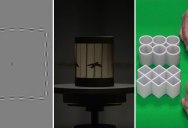The Best Illusions of 2016
by twistedsifter

Since 2005, the Best Illusion of the Year Contest has honored the works of the world’s premier illusion creators in an annual contest that receives submissions from around the world from visual scientists, ophthalmologists, neurologists, and artists that make up the illusion community.
The contest consists of three stages: submission, selection of the Top 10 finalists, and election of the Top 3 winners. Below you will find the winners along with two honourable mentions.
To see all 10 finalists along with the winners from previous years visit: illusionoftheyear.com
1st Place – Motion Integration Unleashed: New Tricks for an Old Dog
Mathew T. Harrison and Gideon P. Caplovitz, University of Nevada Reno, USA
Previous illusions have demonstrated that drifting Gabors that translate across the visual field can appear to move in the wrong direction (i.e. in a direction that is different than the actual translation). Here we show that configurations of drifting Gabors that are stationary can give rise to dramatic global motion percepts: a rotating square, oscillating chopsticks and rolling waves. Although the Gabors themselves are not changing position, the drifting motion within them causes the illusion that the entire configuration is moving! [source]
2nd Place – Ambiguous Cylinder Illusion
Kokichi Sugihara, Meiji University, Japan
The direct views of the objects and their mirror images generate quite different interpretations of the 3D shapes. They look like vertical cylinders, but their sections appear to be different; in one view they appear to be rectangles, while in the other view they appear to be circles. We cannot correct our interpretations although we logically know that they come from the same objects. Even if the object is rotated in front of a viewer, it is difficult to understand the true shape of the object, and thus the illusion does not disappear. [source]
3rd Place – Silhouette Zoetrope
Christine Veras, Nanyang Technological University, Singapore
As an homage to early tropes that have been tricking our senses since the Victorian Era, the Silhouette Zoetrope offers a paradigm shift from the traditional Zoetrope. Not only through the inversion of its structure, but also through the combination between shadow puppet tradition and the early optical toy. The renewal of pre-cinematic optical devices in contemporary times offers a possibility to the public to experience animation beyond the limits of the screen. When the Silhouette Zoetrope is rotated, the slots strobe behind the cutout images, animating them apparently inside the empty slotted cylinder, which creates the illusion of moving silhouettes placed into space. [source]
Finalist – Caught Inside A Bubble
Mark Vergeer, Stuart Anstis and Rob van Lier, University of Leuven, Belgium; Radboud University Nijmegen, The Netherlands; UC San Diego, USA
In this illusion you can see colors that are not presented on the screen. An image of colored bull’s eyes is alternated with an image containing different sized greyscale bubbles. Although these bubbles are colorless, they will actually appear to be colored. These illusory colors are the afterimages of the bull’s eye colors. The intriguing thing is that the colors of the bubbles appear to be completely different, depending on the size of the bubble. Each bubble ‘captures’ the afterimage of the bull’s eye color that matches the size of the bubble. One colored image causes multiple, completely different afterimages. [source]




